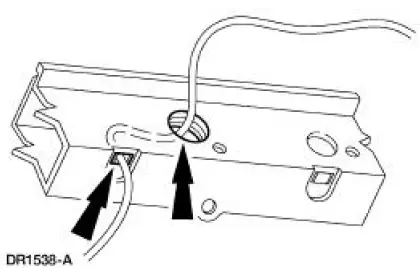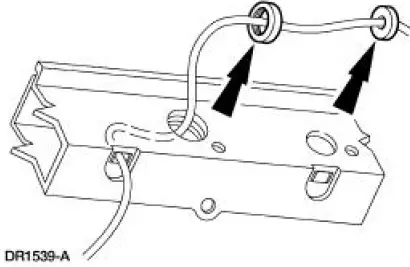Ford Mustang (1999-2004) Service Manual: Weld Nut Repair - Missing Weld Nut, Restraints Control Module (RCM)
WARNING: To avoid accidental deployment and possible personal injury, the backup power supply must be depleted before repairing or replacing any front or side air bag supplemental restraint system (SRS) components and before servicing, replacing, adjusting or striking components near the front or side air bag sensors, such as doors, instrument panel, console, door latches, strikers, seats and hood latches.
Please refer to the appropriate vehicle shop manual to determine location of the front air bag sensors.
The side air bag sensors are located at or near the base of the B-pillar.
To deplete the backup power supply energy, disconnect the battery ground cable and wait at least one minute. Be sure to disconnect auxiliary batteries and power supplies (if equipped).
NOTE: There are two procedures to repair a vehicle having missing restraints control module attaching weld nut(s). Read both procedures before proceeding with the repair.
NOTE: If two or more weld nuts are missing, do not install the "J" nuts as outlined in Weld Nut Repair - "J" Nut, Restraints Control Module (RCM). Weld nuts must be installed as outlined in this procedure.
NOTE: Radiator support repair shown, others are similar.
1. Obtain a 6 mm (0.24 in) weld nut (part number N806285-S190).
2. Obtain a 6 mm (0.24 in) grounding screw (part number N806327-S190).
3. Route a sufficient length of copper welding wire through the weld nut clearance hole and back out an adjacent access hole.

4. Feed the copper welding wire through the weld nut, then through a standard flatwasher.

5. Secure the flatwasher so that it cannot be pulled off the end of the copper welding wire.
6. Pull the copper welding wire back through the clearance hole, allowing the weld nut and flatwasher to follow the copper welding wire through.
7. Position the weld nut to the weld nut clearance hole, firmly pulling on the copper welding wire allowing the secured flatwasher to hold the weld nut in position.
8. Holding the weld nut securely in place and using a MIG welder, weld in four places around the edge of the weld nut.
9. Metal finish as required.
10. Verify the nut is securely in place.
11. Install the crash sensor.
12. Tighten the attaching screws to specification. For additional information, refer to Torque Specifications in this section.
 Weld Nut Repair - "J" Nut, Restraints Control
Module
(RCM)
Weld Nut Repair - "J" Nut, Restraints Control
Module
(RCM)
WARNING: To avoid accidental deployment and possible personal
injury, the backup
power supply must be depleted before repairing or replacing any front or
side air bag
supplemental restraint ...
 Weld Nut Repair - Stripped Weld Nut, Restraints
Control
Module (RCM)
Weld Nut Repair - Stripped Weld Nut, Restraints
Control
Module (RCM)
WARNING: To avoid accidental deployment and possible personal
injury, the backup
power supply must be depleted before repairing or replacing any front or
side air bag
supplemental restraint ...
Other materials:
Torque Converter Turbine to Pump Stator Interference
Check
1. NOTE: Front pump support may remain in front pump support and gear
during this test.
Position the torque converter with the pump drive up.
2. Install the front pump support to engage the mating splines of the front
pump support shaft on
the torque convert ...
Reversing Lamps
Refer to Wiring Diagrams Cell 93 , Backup Lamps for schematic and
connector information.
Special Tool(s)
73III Automotive Meter or
equivalent
105-R0057
Inspection and Verification
1. Verify the customer concern by operating the reversing l ...
Accelerator Cable - 3.8L
Removal and Installation
1. Push the accelerator cable nylon bushing out of the accelerator pedal and
shaft arm.
2. Remove the bolts retaining the accelerator cable to the dash panel.
3. Disconnect the accelerator cable from the throttle body by rotating ...
